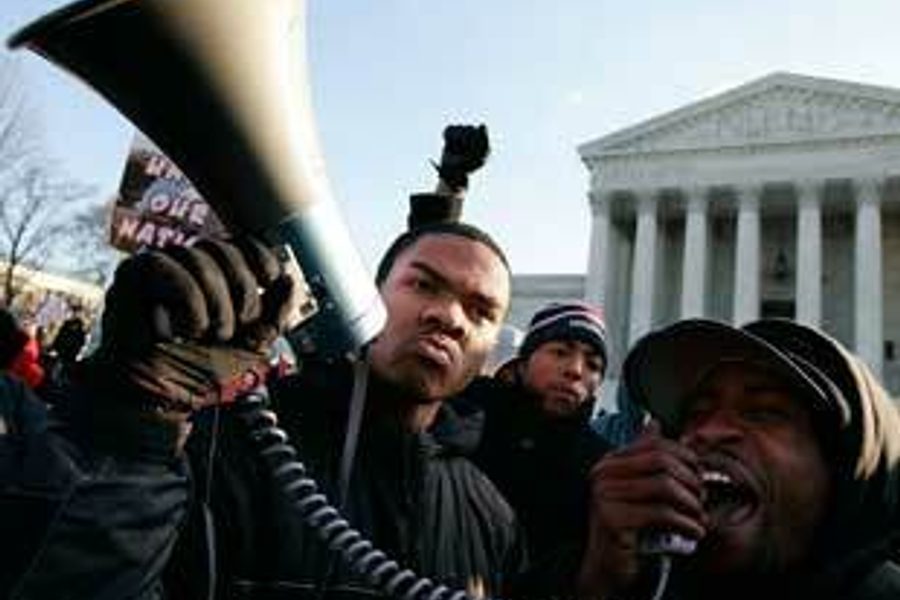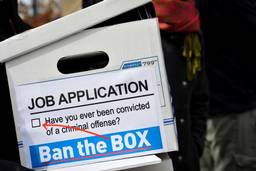A Dream Deferred
Only sustained community activism will reverse the Supreme Court’s most recent betrayal of Brown v. Board of Education
Lewis M. Steel

On June 28, three years after the 50th anniversary of Brown v. Board of Education, the U.S. Supreme Court subverted Brown’s meaning to block public school integration plans. As a result, boards of education across the country, which have used racial criteria to reduce segregation, must undo their efforts or themselves be branded as racial discriminators. Examining the role of the courts and the role of movement activists and attorneys is essential to understanding the history of this reversal.
The 1955 Brown decision came after a 20-year campaign of sustained litigation that was supported by massive organizing and that was finally backed by a Justice Department brief that argued segregation could cause the country to lose its contest with the Soviet Union for the hearts and minds of the Third World. Relying on the Equal Protection Clause of the 14th Amendment, which was passed after the Civil War to ensure former slaves equal rights, the Supreme Court weakened state-enforced segregation in public settings through Brown and a series of subsequent cases.
Despite gains made in the South after Brown and as a result of intense pressure from courageous civil rights activists, which led to the passage of federal laws between 1964 and 1968, desegregation fell into full retreat mode. The Court determined in 1974 that school segregation in the north was an acceptable consequence of segregated housing patterns and geo-political boundaries.
Now, with their June 28 decision in Parents Involved in Community Schools v. Seattle School District No.1, the four justices who comprise the Court’s right-wing bloc, with the concurrence of the more mainstream conservative Justice Anthony Kennedy, have taken what may be the final step in making Brown obsolete. The court condemned the modest attempts by the Seattle and Jefferson County (Louisville), Ky., boards of education to voluntarily reduce segregation by employing race-conscious integration plans. “Foul!” cried the Supreme Court. The same Constitution and the same Brown decision – which, in theory, required desegregation 53 years earlier – now required local boards of education to maintain their segregated schools, unless they could shoehorn themselves into the sliver of an opening for diversity that was provided by Kennedy’s decision.
Chief Justice John Roberts, writing for the majority, reviewed precedents from the 1955 remedy phase of the Brown case (known as the second Brown decision) – which created the insidious “all deliberate speed” formula for desegregating southern schools – through the 2003 University of Michigan cases, in which Justice Sandra Day O’Connor barely saved the consideration of race as a means to increase diversity at the university level. According to Roberts, educating children in a racially integrated environment and ensuring non-white students’ access to desirable schools was different, according to the chief justice. “Racial balancing,” or seeking to remedy “past societal discrimination,” was just another way of discriminating on the basis of race. To Justice Clarence Thomas, concurring with Roberts, arguments in favor of integration were “faddish social theories.” In his dissent, Justice Stephen Breyer demonstrated that the difference between what Roberts said was societally caused (de facto) segregation in Seattle and Louisville and what Roberts said was governmentally caused (de jure) segregation was not clear. Elements of governmentally caused and societal segregation are invariably mixed. In any event, Breyer argued this distinction only had meaning with regard to whether segregation violated the Constitution, not whether boards of education could voluntarily integrate their schools.
Judge Kennedy’s concurrence tried to slip in between the dueling justices. A compelling interest to avoid racial isolation and to achieve integration to create equal opportunity does exist, he wrote. And school administrators should continue “the important work of bringing together students of different racial, ethnic and economic backgrounds.” But, he warned, they should not resort to racial classifications, and should consider instead such devices as magnet schools and enriched academic programs. Straddling the two four-justice camps, Kennedy’s opinion becomes the controlling voice. To the dissenters and the civil rights legal community, however, Kennedy did little more than invite another round of endless litigation.
This tortured outcome raises a more important question than whether a few public school boards may introduce a drop of integration into a sea of segregation. Put simply, do the Court’s negative decisions matter that much any more? Present-day racial discrimination and segregation are still beyond the reach (or at least the will) of the law, leaving millions subjected to the same disadvantages and indignities that existed before the civil rights movement. Life expectancy, imprisonment and unemployment rates as well as educational levels all attest to the racial disparities. Traffic stops for “driving while black” remain a commonplace experience, especially in white neighborhoods. Differing penalties and enforcement of drug laws have turned the prisons into racial holding pens and have eliminated the right to vote for a significant percentage of the black population. The death penalty is disproportionately imposed on people of color. Employers who reject job applicants with “black names” do so with impunity. The real estate industry continues its dodges to separate blacks from whites. Municipalities place subsidized housing and environmentally hazardous projects in neighborhoods of color, while underfunding their public schools, parks and other publicly supported facilities.
Ever since 1955, when the Court’s second Brown decision negated the first ruling’s focus on equal educational opportunities, the Court has, with rare exceptions, slowly but surely ignored or openly turned against meaningful enforcement of the Fourteenth Amendment. In response, Robert L. Carter, a key theoretician in the Brown case as well as the leader of the legal effort to dismantle northern school segregation, criticized the Court for failing to confront racial isolation. Thurgood Marshall, after becoming a Supreme Court justice, lambasted the majorities in the ’70s cases that blocked the desegregation of Detroit’s schools and that allowed Texas to retain a financing system that severely underfunded poor, mostly Latino and black schools. More recently, the renowned NYU law professor and critical race theorist Derrick Bell has argued that black Americans would have been far better off if the Supreme Court had stuck with its 1896 “separate but equal” doctrine and, instead of decrying school segregation in 1954, meaningfully enforced the “but equal” portion of that ruling. According to Bell, black communities then could have continued to build their infrastructures and fought their way to equality.
Knowing the Court’s equivocations, I am convinced it would not have enforced equal funding for black communities. But Bell’s point is that almost anything would have been better than the Court’s substitute for equality. Contrary to its original intent, which conservative justices supposedly venerate, the 14th Amendment’s Equal Protection Clause has been turned against black Americans. It has become whites’ ticket into federal court, successfully used by them to challenge school desegregation, oppose affirmative action in awarding public contracts and limit minority access to public employment. Even when Justice O’Connor cast the tie-breaking vote in the 2003 Michigan Law School case, she called its plan, which at best was an attempt to level the playing field, a form of discrimination that perhaps could be tolerated for only another 25 years.
What the Supreme Court has now done is merely extend the obstacles it has placed in the path to equal opportunities. From a longer historical perspective, one could say that since the Dred Scott decision before the Civil War, a series of court rulings have time and again thwarted the struggle for equal rights. Contrary to the June 29 New York Times editorial that echoed the myth that the Supreme Court since Brown has been “the driving force for integration” and has “never wavered,” the justices have coddled segregationists and given short shrift to meaningful concepts of equality.
Without the force of powerful constituencies giving urgency to their arguments, civil rights lawyers’ pleas for equality do little more than stir the creative juices of those who use their legal skills to make a mockery of that concept. Judges can always find a justification to leave things the way they are or turn back the clock. And even when judges occasionally seek to alter the landscape, they are prone to ignoring their own pronouncements.
Two years ago, I was a speaker at an Ohio State University Law School symposium concerning post-Brown judicial struggles. People from the Columbus community expressed their anger at the Ohio Supreme Court for not enforcing its own decision requiring equal public school funding under the state constitution. Three times, the court had failed to enforce its own decree, one man complained bitterly. “What are you lawyers going to do about it?” he asked. “This is the state capital, isn’t it?” I replied. “Both the court and the legislature sit here. Have you organized protests? What have you done?” The answer, as far as I could tell, was very little.
Progressive forces still need civil rights lawyers to protect activists, help expose injustices and move the law along when communities demand change and are organized to fight for it. Even this most repressive Supreme Court decision, with the Kennedy concurrence and the Breyer dissent, contains the possible seeds of a more progressive future for public education. Well-funded magnet schools and enriched academic programs can serve the needs of black as well as white school children. But without sustained activism, this latest Supreme Court decision will stand as a monument to the right-wing takeover of even the verbiage of equality.
The justices have eyes and ears, as do those who appoint and confirm them. Whether the Kennedy concurrence can be used as a wedge to open doors or will become just another weak and forgotten voice depends upon the people who have a stake in the outcome, which is all of us.




